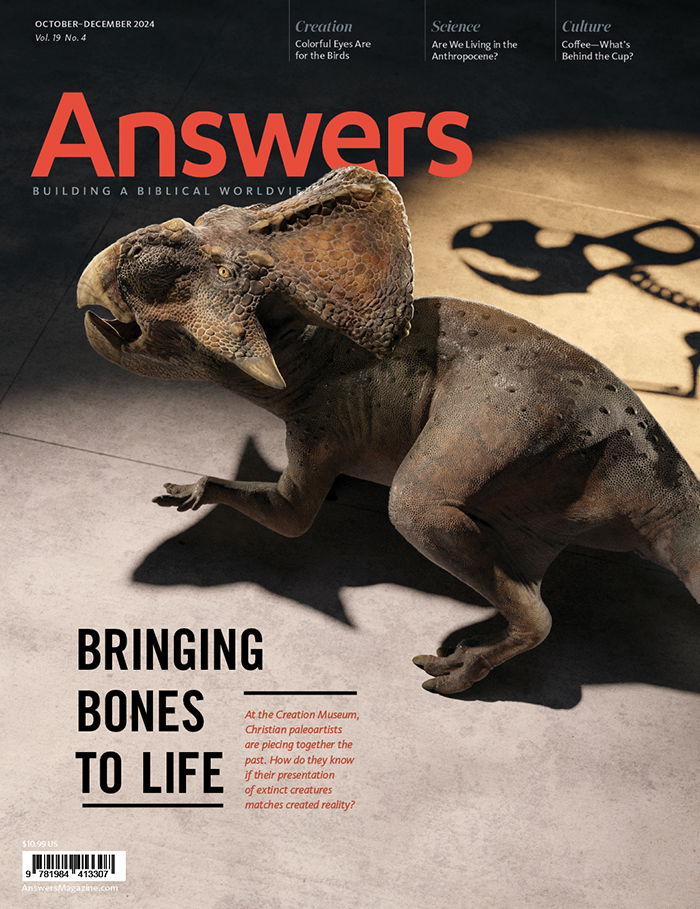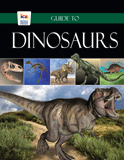Bringing Bones to Life
At the Creation museum, Christian paleoartists are piecing together the past. How do they know if their presentation of extinct creatures matches created reality?
From TV shows and movies to car decals, inflatable costumes, and children’s pajamas, we’re surrounded by depictions of dinosaurs. We easily recognize the three horns of a Triceratops. We poke fun at the mighty T. rex’s miniature arms. We gape in wonder at the wingspan of a Quetzalcoatlus. But are these fantastic monsters based on anything more than an artist’s overactive imagination?
Sure, we’ve found some bones, but can they really tell us anything about the way these creatures lived or what they looked like? Are the dinosaurs we think we know so well simply a combination of parts and pieces welded together by some paleontological Dr. Frankenstein? Or is there more scientific evidence behind resurrecting these giants of the past?
What Is Paleoart?
Webster’s dictionary defines paleoart as “art that depicts prehistoric life or environments and that is based on fossil evidence [emphasis added].” By this definition, all true paleoart should be based on scientific findings, to some degree. This means that conscientious paleoartists don’t have the freedom to illustrate or sculpt dinosaurs with any appearance, pose, or environment they choose. They should be sure that their depiction of a particular dinosaur or other extinct animal is not contradictory to any established findings.
Information on extinct creatures has historically been very limited, causing scientists and artists to rely on speculation and assumptions when portraying these creatures. This is where the worldview of the paleontologist presenting information and the paleoartist representing information come into play.

Paleoartists influenced by an evolutionary worldview will be more apt to fill in gaps with assumptions supporting billions of years of evolution, transitional forms, and supposed ancestry between what creationists know are distinct kinds of animals (dinosaurs and birds, for example).
Paleoartists holding to a young-earth creationist worldview would reject the idea of “prehistoric life” and be more apt to fill in gaps with their understanding of God’s creation of distinct kinds all within the creation week, only around 6,000 years ago.
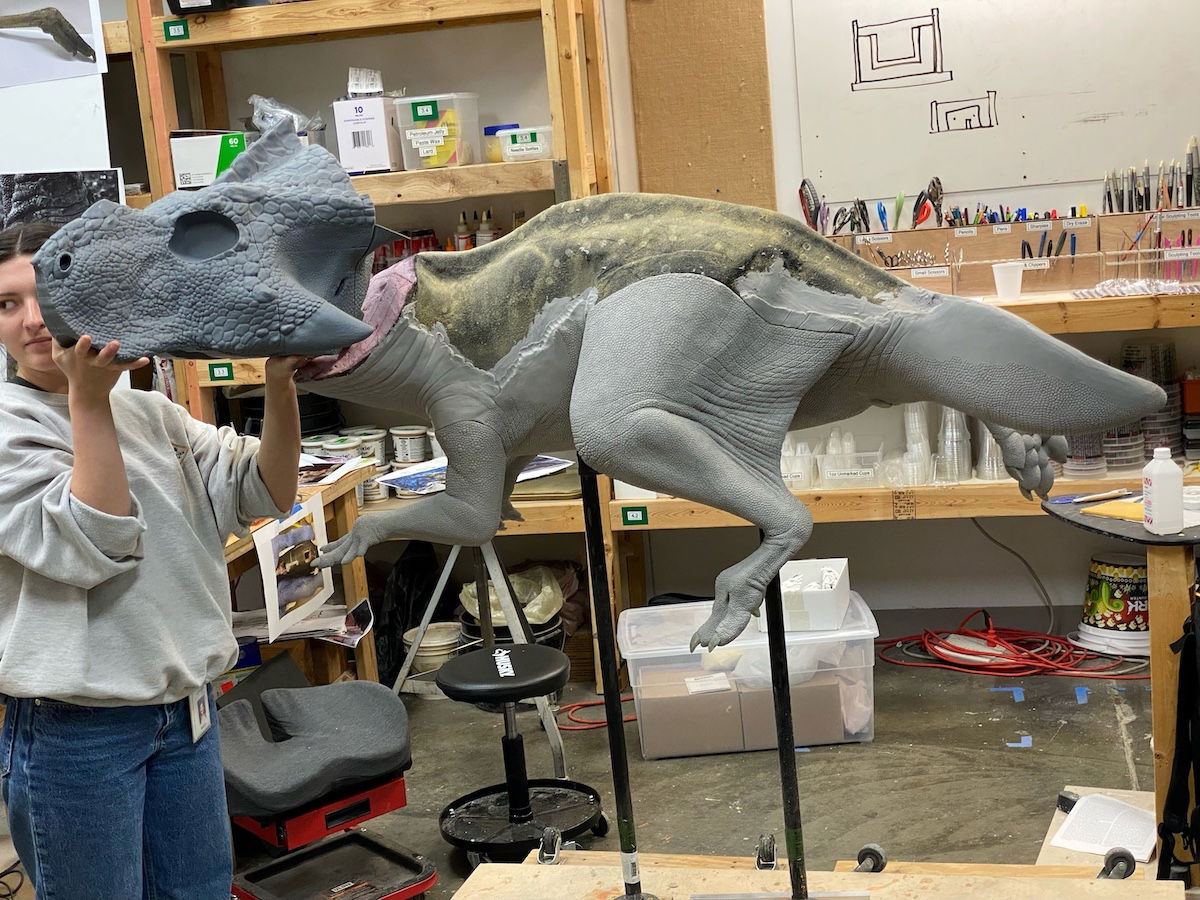
Planning, researching, sketching, digital sculpting, 3D printing, clay sculpting— it takes a lot of work to piece together the past.
The field of paleontology has come a long way from its early days of dreaming up an entire dinosaur from just a few bones. Modern science has greatly increased the amount of data available to paleontologists and artists holding to both worldviews. Consequently, modern paleoart is often backed by much more hard evidence than the average museum guest or documentary viewer might expect. More than ever before, biblical creationists can now reconstruct these famed giants of our past, following clues from God’s creation rather than relying on guesses posited by evolutionary theories.
Starting Points
Recently, the Answers in Genesis (AiG) attractions design team finished crafting a sculpture of Protoceratops andrewsi (a ceratopsian dinosaur not much bigger than a sheep) for the Creation Museum’s Starting Points exhibit. The exhibit already showed how people can reach different conclusions about the past using the same evidence. The Protoceratops fossilization display expands on that theme.
Based on actual Protoceratops specimens found at Ukhaa Tolgod, Mongolia, one cast of the sculpture is suspended above guests as if the creature is struggling within the flood waters. A second cast appears as if it’s being buried by an avalanche of sand and rainwater.
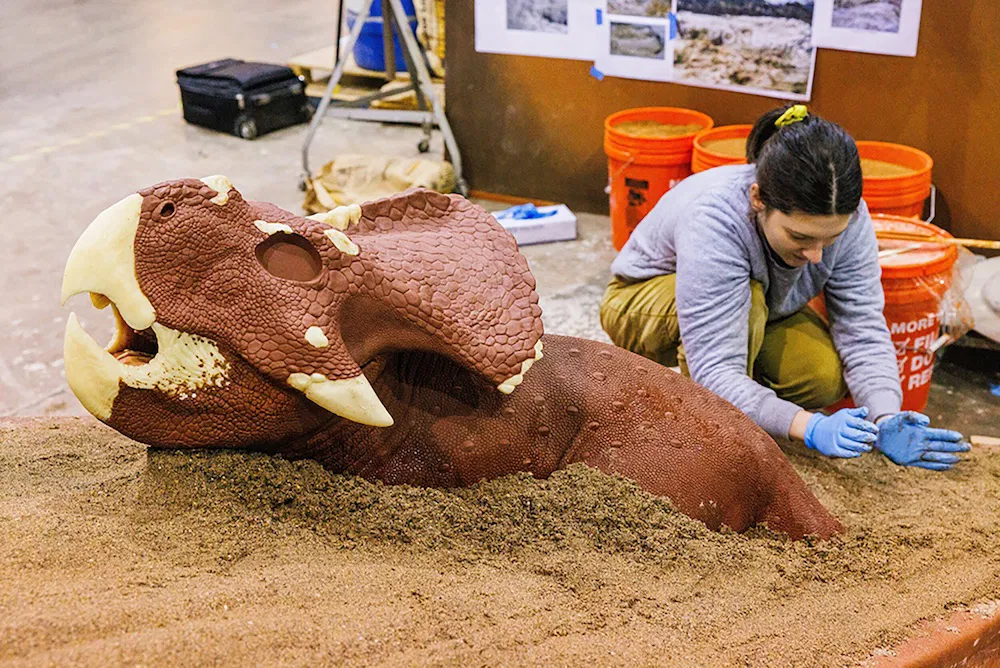
The display shows guests how the circumstances of the burial are best explained within the context of the global flood. The scene and its accompanying narrative not only showcase the ability of paleoartistry to highlight the creativity of our wise Creator but will also demonstrate how worldview influences interpretation of fossils.
Worldview no doubt played a big part in interpreting the evidence for how the Protoceratops fossils, which inspired the exhibit, were formed. However, the sculptures on display are created from much objective evidence recognized by both evolutionists and creationists.
The World's Most Accurate Protoceratops
Mike Belknap, a content writer for the attractions design team, was heavily involved in the research and design of the dinosaur sculptures for this display. Since childhood, Mike has studied dinosaurs and other extinct animals. During his 10 years as a content writer with AiG, Mike has invested countless hours researching fossils, dinosaurs, and other mysteries of the past.
Besides writing sign content for the attractions, Mike periodically creates illustrations and sketches of extinct animals based on fossil evidence to serve as references for other artists working on the exhibits. He’s also helped sculpt the forms for multiple animals featured in the Ark Encounter, AiG’s life-size ark attraction in Northern Kentucky.
The attractions design department often teases Mike about the many rounds of revision he puts projects through in his pursuit of accuracy. But Mike’s commitment to accuracy has been a key force in constructing what the team believes to be the world’s most accurate sculpture of a Protoceratops to date.
Monsters Made to Make Him Known
Humans have always taken a special interest in giant creatures. There’s something awe-inspiring about a living organism that towers above you like a skyscraper and chomps on a car as if it were a toy. Humanity’s engrossment in the gargantuan has sparked many works of art depicting extinct or imaginary creatures of what some scientists would call “prehistoric” proportions—from cave paintings to stunning CGI masterpieces in modern movies.
Unfortunately, modern movies miss the most awe-inspiring part about monstrously large creatures. The real mighty “monsters” that existed in our not-so-distant past (dinosaurs, pterosaurs, and giant extinct sea creatures like megalodons and ichthyosaurs) weren’t created to cause destruction. They were created to show the astounding power of a God who created them by his word.
Of course, after sin entered the world, many of these creatures became carnivorous and, as a result, more destructive. But their massive stature and beautifully complex design still testifies to their original purpose.
Cinematic versions of dinosaurs and other giants haven’t lost the awe that the real giants of creation evoked, but they haven’t fully captured it either. A rampaging monster reflects nothing greater than its own limited power. The true giants of creation bring to mind the power of a God who upholds the whole universe and holds the keys to life and death.
The Plans for "Proto"
The process of creating the sculptures for the Starting Points exhibit began in 2018. Artists designed the display, digitally sculpted the body and head of a Protoceratops, then cut out a rough foam form of the body on the studio’s CNC machine. The design team used this one form to cast the two sculptures needed for the exhibit.
As other projects took priority, “Proto”—as Mike nicknamed the sculpture—sat on the shelf. When the team’s attention finally turned back to the project over a year ago, Doug Henderson, the supervising art director, and Mike took the opportunity to pose the static foam form more dynamically, particularly the more visible of the sculptures displayed suspended amid driftwood, appearing to float in the waters of the flood.
“He originally just looked like he was kinda floating along,” Mike said. “We wanted to make it look more like he was swimming and actually trying to survive.”
But when Mike removed Proto’s foam limbs to re-pose them, he realized that the change would not be that easy.
When the skeletal structure of a living thing moves, it affects the way muscles contract and extend, making the overall shape of the creature different in key ways. Though Proto didn’t have a true skeleton underneath his foam form, he needed to look as if he did. If Mike wanted to re-pose the dinosaur, he would have to resculpt its form by hand. Back he went to his research to discover how a ceratopsian dinosaur’s skeleton and muscles would operate in a swimming pose.

To make the sculpture look as if it is swimming, Mike resculpted the original form by shaving off pieces and filling in parts with spray foam.
Three months passed as Mike shaved off some places, filled in others with spray foam, sanded, and completely restructured Proto’s body. This deep dive into ceratopsian anatomy resulted in not only a more dynamic pose but also a more accurate sculpture overall.
During this time, exhibit artists sculpted Proto’s feet from clay and meticulously covered them in a scale pattern with an assortment of small tools that resembled those on a dentist’s tray.
When Mike completed the foam form, the artists began sculpting scales for the rest of the body and prepared to 3D print Proto’s head.

Mike draws a scale pattern that artists will later meticulously sculpt.
Fleshing Out the Idea
A lot of people think depictions of a dinosaur’s more cosmetic features (musculature, skin, scales, and fibers) are just a heavy layer of speculation spread over fossil evidence like a generous layer of icing atop a stale cake. But there is a lot more to fleshing out these creatures.
Skeletons can be found with preserved soft tissue and often feature clues to soft tissue structures that were not preserved along with them. For example, attachment points for muscles can shed light on a dinosaur’s proportions, and holes in certain areas of the skull, called neurovascular foramina (which would have allowed for the passage of nerves and blood vessels), can indicate the presence of relatively thick, fleshy elements around the mouth, maybe even simple cheeks. The size and depth of a fossil specimen’s sclerotic rings (bony structures which would have encircled its eyes) can give clues to whether a dinosaur was active at night, during the day, or both. In the case of Protoceratops, evidence seems to point to excellent low-light vision, indicating that this creature had the capacity for at least partial nocturnal activity.
Though soft tissue, such as skin and scales, is not commonly preserved in fossils, there are notable exceptions. For example, preserved within a volcanic mudslide, one specimen of Psittacosaurus1 (a ceratopsian similar to Protoceratops in many respects) contained preserved examples of scale types in various zones across the creature’s body, uropatagia (sails of skin running along the back of its legs from its ankles to the base of its tail), an umbilical scar, and a cloaca (a cavity at the end of this creature’s digestive tract which allowed for the release of both excrement and eggs). The scale patterns of this specimen and their distribution across the body compare favorably with textural data found in other ceratopsian specimens.
Of course, features like skin color and body areas are still susceptible to interpretation. That’s why we must compare them with the features of extant creatures. But the extensive evidence now available for Psittacosaurus makes it possible to portray the appearance of dinosaurs within their own, and similar, species with much greater confidence.
Since the Protoceratops is known to be very similar to Psittacosaurus in its anatomy, it made sense for Proto to reflect many of the features represented on the Psittacosaurus specimen. Guided by a scale map Mike created in Photoshop to represent research findings, the artists’ hand-sculpted scales follow the patterns and zones represented in the preserved Psittacosaurus flesh. The artists also gave Proto a meticulously sculpted cloaca and umbilical scar.
Getting a Head
To prepare Proto’s head for printing, the 3D artist began digitally sculpting the interior of the mouth (inspired by snapping turtles, which have a similar beak, and tortoises, which better represent the Protoceratops’ life on land). As Mike consulted the artists on the construction of these features, he took the opportunity to ensure that the shape of Proto’s head was as accurate as the body. The original head had been digitally sculpted based on an artist’s reconstruction of a Protoceratops skull, but Mike wanted the head adjusted to fit a specific Protoceratops fossil instead. With the time that it would take to complete the scale pattern on Proto’s body, Mike could take this additional step to ensure greater precision.
When the body was completely sculpted, the finished head was 3D printed and attached. The form was now ready for the artists to create the custom silicone mold they would use to cast the two final Protoceratops sculptures from a combination of resin, foam, and fiberglass. After cleaning the casts, the artists prepared to add the paint.
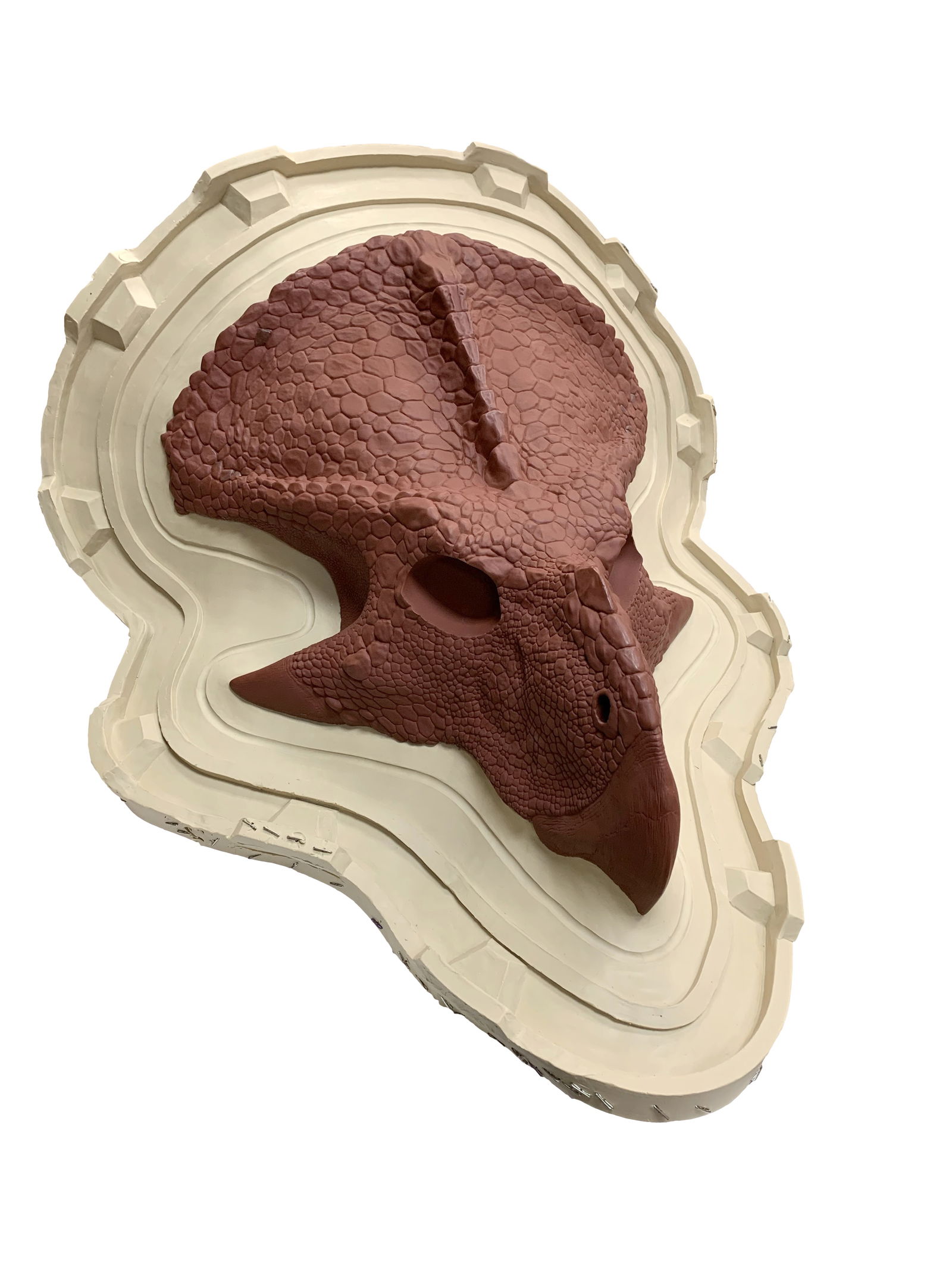
Proto’s head was digitally sculpted and 3D printed while the scale pattern on the rest of the body was sculpted by hand.
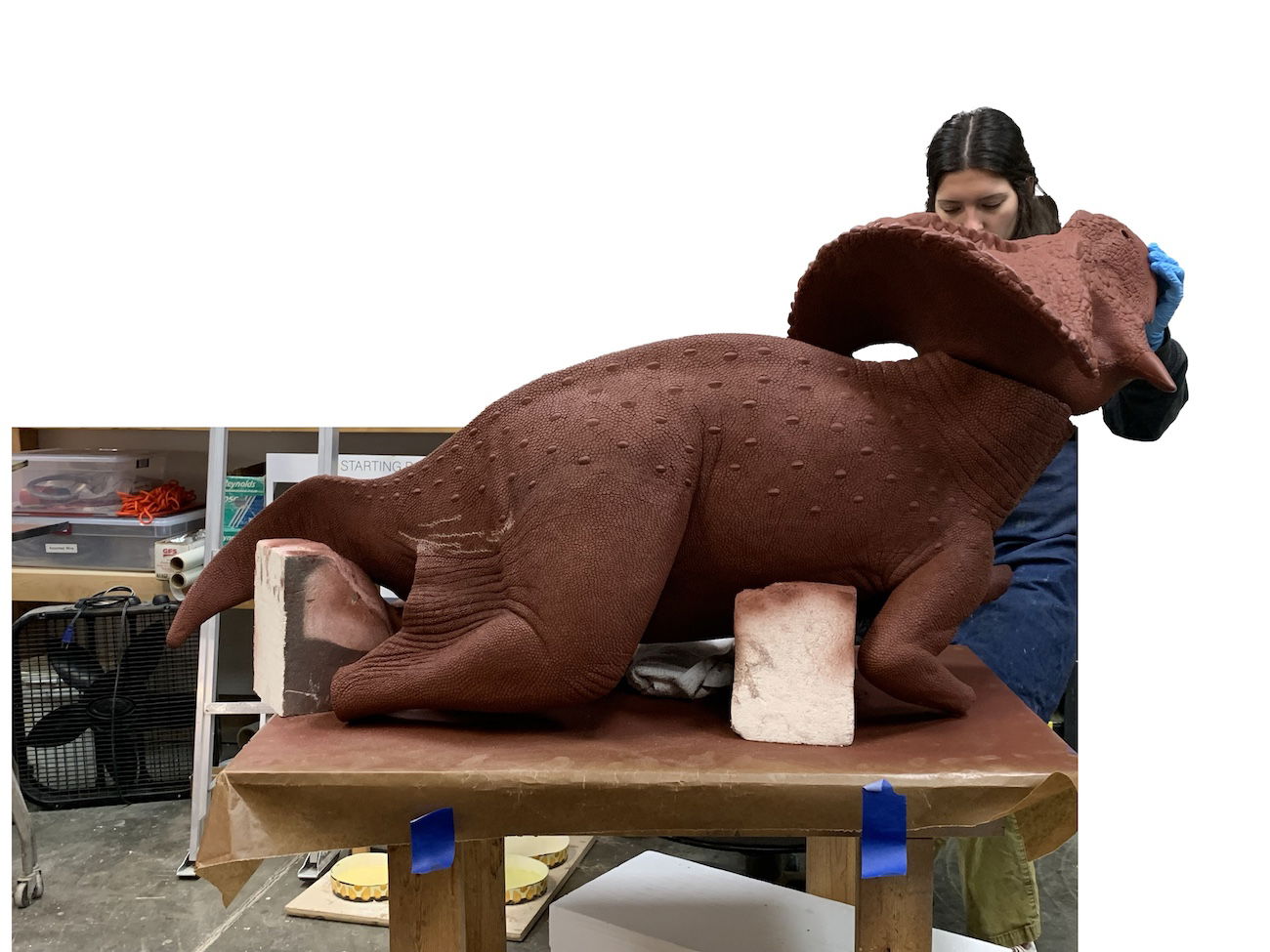
Coloring Within the Lines
When you walk through a museum, dinosaur bones are not the place you look for a pop of color. Even specimens of fossilized skin and scales are typically devoid of their original pigment—or so it seems on the outside. When viewed with an electron microscope, fossils can reveal the secrets hidden within their drab, stony exterior, bringing the world of dinosaurs to life in color.
Scientists have discovered that melanosomes (cell structures that contain pigment) can survive in fossil specimens. When precautions are taken to distinguish melanosomes from microbes, the size, shape, and configuration of these cells can sometimes tell us what colors the fossilized creature displayed. Using both pigment data found in fossils and the comparative coloring found on similar modern creatures, paleoartists can achieve a degree of accuracy which would have seemed impossible years ago.
Proto’s paint job was influenced by pigments found in Psittacosaurus fossils. The pigment data for this creature revealed that its scales were covered in a pattern of light and dark pigments that does not follow its scale pattern, also known as countershading. A similar complex pattern serves as camouflage for the modern Texas horned lizard. Countershading is suspected to have functioned similarly for members of Ceratopsia like Psittacosaurus and Protoceratops.
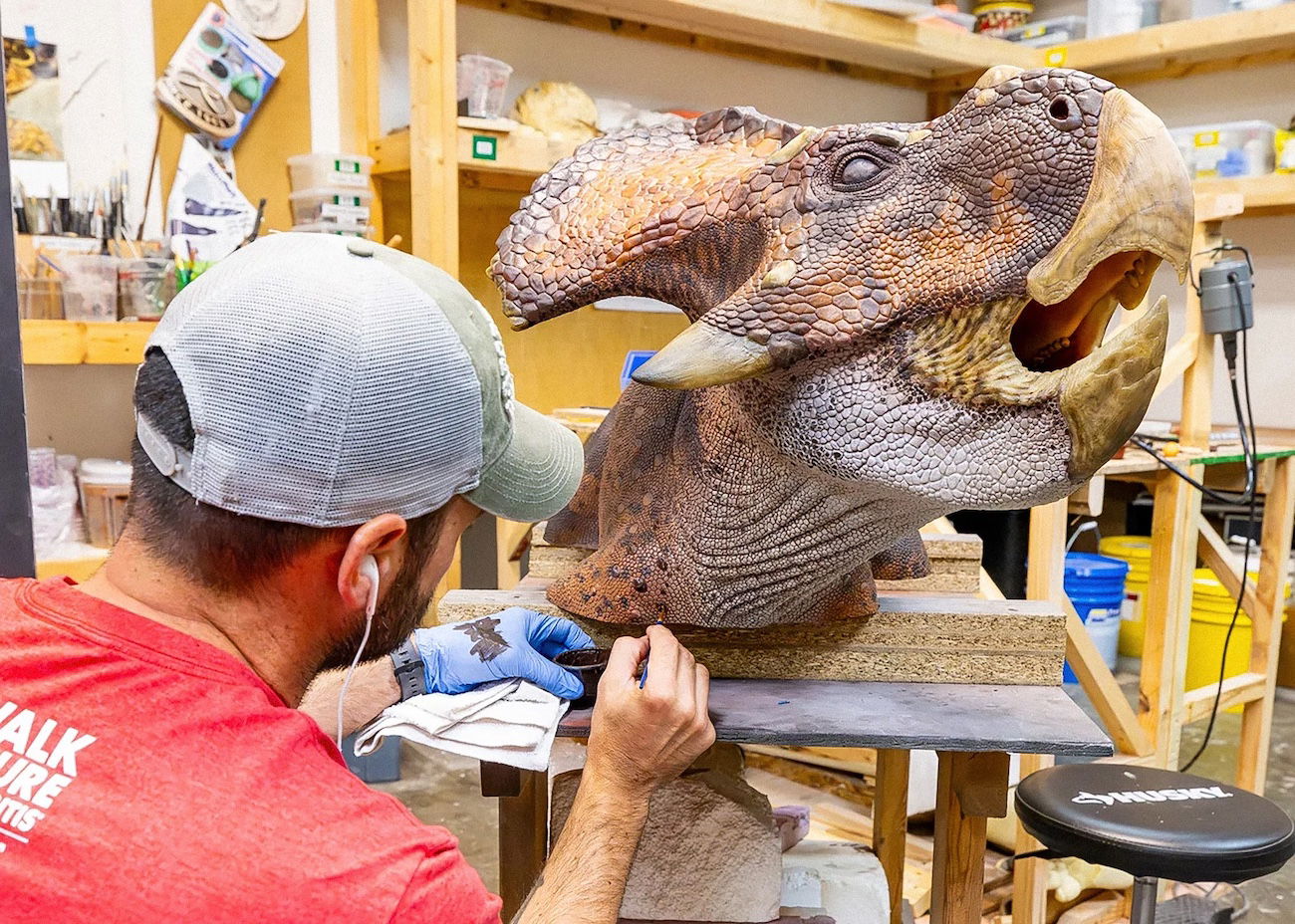
An artist works on the final paint job for the Protoceratops exhibit.
Worth the Work
Working on Proto was tedious for everyone involved. Days droned on to the buzzing of the saw. Flakes of orange foam tracked a path from the sculpting room to the content writers’ cubicle. And the exhibit artists spent months bent over small patches of clay, meticulously shaping tiny scale patterns and adding natural creases and folds to the skin.
But the tedium paid off. In Mike’s estimation, “It truly is the best Protoceratops sculpture in the world.” The sculptures feature a level of quality that museums don’t typically have the time or resources to achieve. Most museum dinosaur sculptures are created using what Mike called “understandable shortcuts,” such as texture pads for stamping repeating scale patterns. These pads give the dinosaur’s skin a sort of artificial look, whereas the tedious sculpting of each individual scale allows for more accuracy to the variety of patterns that would have been found across different parts of a dinosaur’s body—and thus a more realistic-looking sculpture.
Mike also noted that most museums hire outside studios to create their dinosaur sculptures rather than having an in-house design studio create them like AiG does. “They can’t afford to pay an outside company to spend this many hours making sure a piece is accurate,” Mike explained. “They also don’t usually have someone who is ridiculously obsessed with dinosaurs directly overseeing the entire process.”
An "Evolving" Understanding
The attractions design team’s Protoceratops sculptures show how new discoveries and developing technology can help us create more accurate works of paleoart than we would have been capable of creating in the past. Without the discovery of a well-preserved ceratopsian dinosaur and the use of an electron microscope, the scale pattern and other fleshy structures of the Protoceratops sculpture would have relied on much more speculation.
As technology advances and more information about dinosaurs and other extinct creatures becomes accessible, we often find that previous works of paleoart are not as accurate as we thought. For example, Edmontosaurus regalis was represented as a rather plain, duck-billed dinosaur for decades. Then in 2011, an Edmontosaurus fossil was found with a preserved fleshy crest on its head, measuring 8 inches tall and a foot long. As a result, paleoartists had to adjust their depictions of this dinosaur to reflect this new data.
Sometimes, all it takes to discover that a dinosaur has been portrayed inaccurately is further study of existing evidence. You might have seen the way some of the dinosaurs in the popular film Jurassic Park hold their arms—in front of their bodies and pronated, a pose often referred to as bunny hands. In 2013, a study by VanBuren and Bonnan showed that many dinosaurs were incapable of attaining the “bunny hands” position. Unlike humans, these dinosaurs could not have rotated their radiuses over their ulnas, a movement that is necessary to bring the arms close to the body with the palms downward, as these dinosaurs were so commonly posed.
As new information becomes available, paleoartists who are biblical creationists should be the most strongly compelled to accurately depict God’s creatures. This does not mean we capitulate to every change suggested by evolutionary assumptions, but it does mean that when new credible and reasonable data is made available by creation or secular scientists, paleoartists must be humble enough to learn and correct their understanding of God’s complex creation.
“Our comprehension of these creatures is constantly changing,” Mike said. “That’s just the nature of scientific discovery. Those of us who value God’s creation should be the ones pushing paleoart forward. We need to embrace the truth, even if it’s weirder than we thought it could ever be.”
As time passes, we may find new information that causes us to rethink our portrayal of Protoceratops. But with Scripture as our starting point, we can be confident that the only thing evolving is our understanding of God’s creation.
Answers Magazine
October–December 2024
At the Creation Museum, Christian paleoartists are piecing together the past. How do they know if their presentation of extinct creatures matches created reality?
Browse IssueFootnotes
- Phil R. Bell et.al., “The Exquisitely Preserved Dinosaur Skin of Psittacosaurus and the Scaly Skin of Ceratopsian Dinosaurs,” Research Gate, February 18, 2022, https://www.researchgate.net/figure/Psittacosaurus-sp-SMF-R-4970-under-laser-stimulated-fluorescence-LSF-and_fig1_359333932.
Recommended Resources

Answers in Genesis is an apologetics ministry, dedicated to helping Christians defend their faith and proclaim the good news of Jesus Christ.
- Customer Service 800.778.3390
- Available Monday–Friday | 9 AM–5 PM ET
- © 2026 Answers in Genesis



